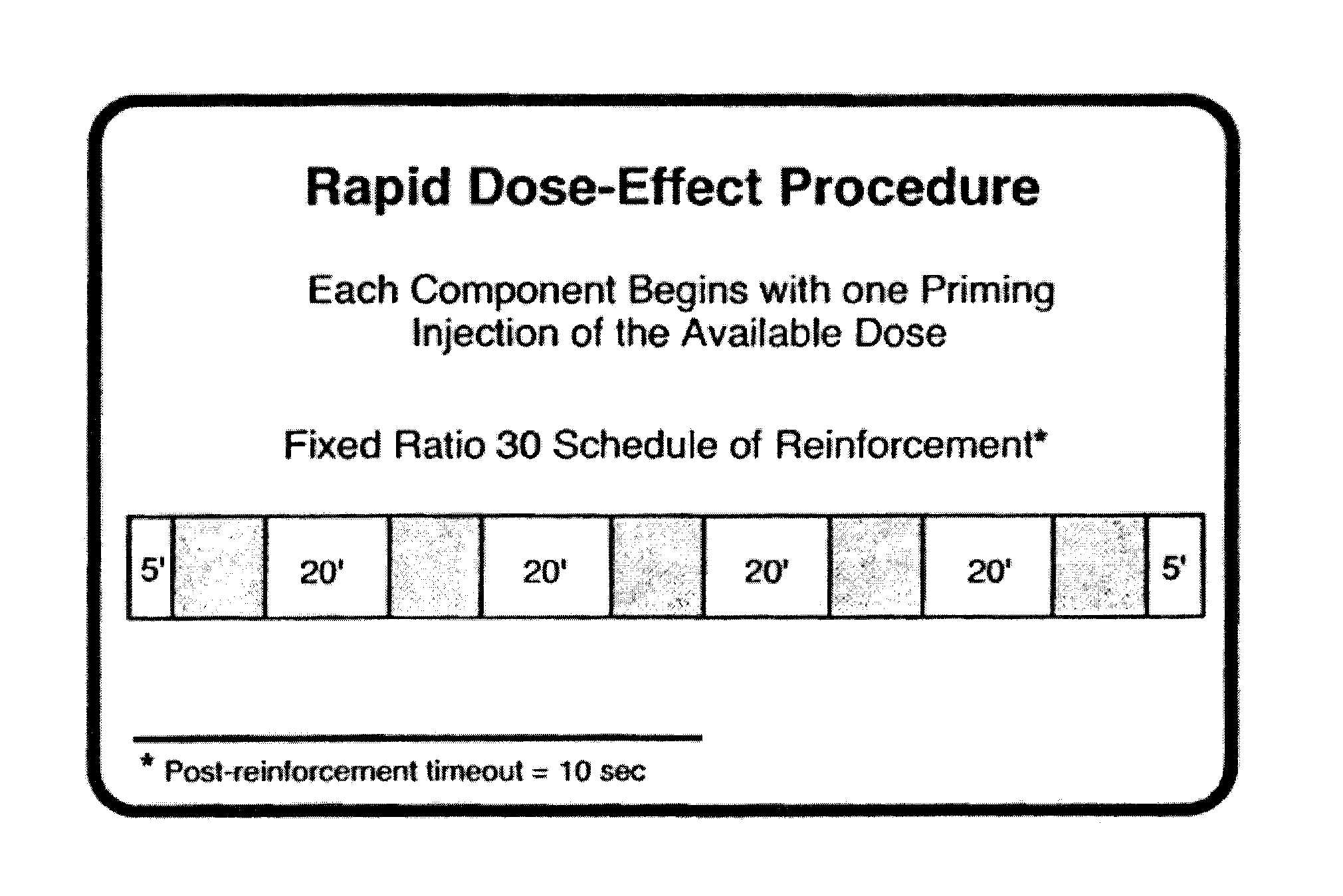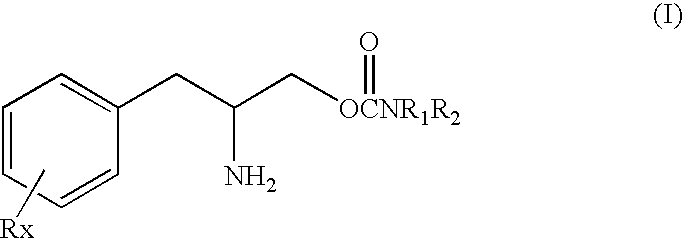Methods for treating drug addiction and improving addiction-related behavior
a drug addiction and behavior modification technology, applied in the field of opioids, can solve the problems of gastrointestinal absorption slowness, dopamine deficiency, and devastating effects of addiction, and achieve the effect of reducing or eliminating the effects of addiction
- Summary
- Abstract
- Description
- Claims
- Application Information
AI Technical Summary
Benefits of technology
Problems solved by technology
Method used
Image
Examples
example 1
[0149]The test compound (O-carbamoyl-(D)-phenylalaminol) substituted fully for the discriminative stimulus effects produced by 10 mg / kg of cocaine (ED50=37.43 mg / kg). Response rate was decreased to 41% of control following 100 mg / kg of test compound.
[0150](Methods)
[0151]Test compound was tested for its ability to substitute for the discriminative stimulus effects of cocaine (10 mg / kg) in rats.
[0152]Six male Sprague-Dawley rats were trained to discriminate cocaine (10 mg / kg) from saline using a two-lever choice methodology. Food was available as a reinforcer under a fixed ratio 10 schedule when responding occurred on the injection appropriate lever. All tests occurred in standard, commercially available chambers (Coulbourn Instruments), using 45 mg food pellets (Bioserve) as reinforcers.
[0153]Training sessions occurred in a double alternating fashion, and tests were conducted between pairs of identical training sessions (i.e., between either two saline or two cocaine training session...
example 2
[0158]Test compound (O-carbamoyl-(D)-phenylalaminol) (0.1-18 mg / kg) was evaluated for its ability to substitute for cocaine in four monkeys trained to discriminate cocaine (0.40 mg / kg) from saline in a drug discrimination procedure. Test compound produced dose-dependent and complete substitution for cocaine in all four monkeys. Across the dose range tested, Test compound increased response rates in two monkeys, and cocaine also increased response rates in these two monkeys. In a third monkey, neither test compound nor cocaine altered response rates, and in a fourth monkey, both test compound and cocaine decreased response rates. Test compound also did not produce overt behavioral effects across the dose-range tested. These findings suggest that test compound produces cocaine-like behavioral effects in rhesus monkeys and is approximately 20-fold less potent than cocaine.
[0159](Methods)
[0160]Subjects: The subjects were four male rhesus monkeys (Macaca mulatta) each weighing 7.0-8.0 kg...
example 3
[0182]The test compound (O-carbamoyl-(D)-phenylalaminol) was tested for the effects on cocaine self-administration in rhesus monkeys. Rhesus monkeys were trained to self-administer cocaine (0.032 mg / kg / inj, i.v.) and 1 g banana-flavored food pellets during 2-hr experimental sessions in the Rapid Assessment Procedure. Each session consisted of four 20-min components of drug availability (100-min), each separated by a 5-min timeout period. The four components of drug availability were preceded and followed by 9 min components of food availability. During training, unit doses of cocaine were varied across components of the session (0.001-0.03 or 0.01-0.32 mg / kg / inj) to provide full dose effect curves for cocaine self-administration. The position and slope of the dose-effect curve varied among monkeys and, generally, was represented by an inverted-U shape function characteristic for cocaine self-administration under fixed-ratio schedules. In some sessions, the unit dose of cocaine at th...
PUM
| Property | Measurement | Unit |
|---|---|---|
| weight | aaaaa | aaaaa |
| volumes | aaaaa | aaaaa |
| concentrations | aaaaa | aaaaa |
Abstract
Description
Claims
Application Information
 Login to View More
Login to View More - R&D
- Intellectual Property
- Life Sciences
- Materials
- Tech Scout
- Unparalleled Data Quality
- Higher Quality Content
- 60% Fewer Hallucinations
Browse by: Latest US Patents, China's latest patents, Technical Efficacy Thesaurus, Application Domain, Technology Topic, Popular Technical Reports.
© 2025 PatSnap. All rights reserved.Legal|Privacy policy|Modern Slavery Act Transparency Statement|Sitemap|About US| Contact US: help@patsnap.com



